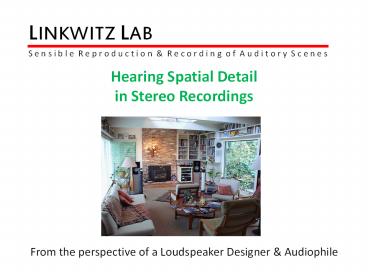LINKWITZ LAB - PowerPoint PPT Presentation
Title:
LINKWITZ LAB
Description:
Thank you for your attention. There will be a Demonstration of Hearing Spatial Detail Room A, CCL Level +2. Friday, 10:00 to 19:00. Saturday, 10:00 to 19:00 – PowerPoint PPT presentation
Number of Views:81
Avg rating:3.0/5.0
Title: LINKWITZ LAB
1
LINKWITZ LAB
S e n s i b l e R e p r o d u c t i o n R e
c o r d i n g o f A u d i t o r y S c e n e s
Hearing Spatial Detail in Stereo Recordings
From the perspective of a Loudspeaker Designer
Audiophile
2
Recording the Eardrum Signal
Multiple Sound Streams in Time Space
- Ear signal Sum of
- Instruments
- Voices
- Noises
- Hall reflections
3
Playback of the Recording
- The response to the stimulus
- The Auditory Scene
4
Issues with Binaural
- Eardrum signals
- Individual anatomy dependent
- No movement tracking
- Auditory Scene
- Foreshortened distances
- In-head localization
5
A single Loudspeaker in a Room
ACOUSTICS
- Direct sound
- Reflected sound
- Reverberation
Dipole loudspeaker near a room corner
6
A single Loudspeaker in a Room
HEARING
- Direction
- Distance
- Room
- Tonality versus head movement
- Pattern recognition
- Intelligibility
- Gestalt
- Horizon
- Spatial Hearing
- Sound Streams
Dipole loudspeaker near a room corner
7
Frequency Responsefor a single Loudspeaker in a
Room
On-axis Flat Off-axis Frequency independentat
every angle -gt acoustically small sourceRoom
response Anechoic ltgt Reverberant Frequency
independent?
8
Monaural Phantom Sourcebetween two Loudspeakers
HEARING
- Unnatural phenomenon
- Localization versus head movement
- Distance
- Size
- Tonality versus head movement
9
Optimizing the Phantom Sourcebetween two
Loudspeakers
- Cross-talkcancellation
- 30 degree HRTF
- Sweet Spot size
- Reverberant sound
- Naturalness
10
Head-Related-Transfer-Functions
Diffraction
Level at a point on a rigid sphere relative to
the level without the sphere
Level at eardrum relative to frontal incidence
at 00
Duda Martens, 1998
11
Optimizing the Phantom Sourcewithout XTC in a
Room
- Off-axis Response
- As on-axis
- Lower level
- Reflections
- Symmetry
- Delay
- Source types
- Omni
- Dipole
- Cardioid
- Other?
12
On-axis Frequency Response ?
Level at 22.50 450incidence relative to 00
incidence
(22.50)
17.5 cm diameter
450
3.3 dB
Level at a point on a rigid sphere relative to
the level at the center without the sphere
22.50
0 dB
Inverse of empirical EQ
Shaw, 1974
13
Optimizing the Room Setup
- Loudspeaker-Listener triangle
- Symmetry to reflective surfaces
- Loudspeakers out in the room
- Lively room
- Diffuse End
- Dead End
Perceptually hiding Loudspeakers Room
14
Phantom Source Placementhorizontally by channel
differences
Damaske, 2008
Duplex Theory of Directional Hearing
Inter-aural Time Differences (ITD) at low
frequencies Inter-aural Level Differences (ILD)
at high frequencies (Ignoring HRTF changes)
15
Recording as Creation of Art
Timbre Localization Spaciousness
The Mix of microphone signals
16
Distance - Perspective - Loudness - Size
Scaling the Auditory Scene
17
An appropriate radiation patternand setup of
loudspeakers are essential to Phantom Source
Creation and to experience Stereooptimally in a
roomSTEREO System ILLUSION Engine
18
LINKWITZ LAB
S e n s i b l e R e p r o d u c t i o n R e
c o r d i n g o f A u d i t o r y S c e n e s
19
Thank you for your attention
There will be a Demonstration of Hearing Spatial
Detail Room A, CCL Level 2 Friday, 1000 to
1900 Saturday, 1000 to 1900 Pluto-2.1 Stereo
Loudspeakers will be used (Small, active 2-way
loudspeaker with omni-directional radiation
characteristics below 4 kHz)































